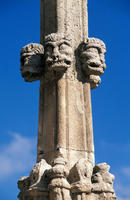You are in: Europe -> Spain -> Burgos Cathedral, and traditional search or Image Gallery will yield results of this site only
Burgos Cathedral
| Site number: | 316 |
|
| Type of site: | Cultural | |
| Date: | 13th century | |
| Date of Inscription: | 1984 | |
| Location: | Europe, Spain, Province of Burgos, Autonomous Community of Castile-Leon | |
Up to 75 images are shown here. Click on each for more details or on Image Gallery for more images.
| Description: | The building of the Our Lady of Burgos site started at the same time as the great cathedrals of the Ile-de-France in the 13th century, it was completed in the 15th and 16th centuries. Its splendid architecture perfectly sums up the whole history of Gothic art; it also showcases a unique collection of art works, including paintings, choir stalls, reredos, tombs and stained-glass windows. --WHMNet paraphrase from the description at WHC Site, where additional information is available. | |
| The Burgos Cathedral (Spanish: Catedral de Burgos) is a Gothic-style cathedral in Burgos, Spain. It is dedicated to the Virgin Mary and is famous for its vast size and unique architecture. The construction of the cathedral was ordered by King Ferdinand III of Castile and Mauricio, the English-born Bishop of Burgos. Construction started on the site of the former Romanesque cathedral on July 20, 1221, beginning at the chevet, which was completed in nine years. The high altar was first consecrated in 1260, then there was a lengthy hiatus of almost 200 years before construction was recommenced. The cathedral was completed in 1567, with the completion of the lantern spire over the main crossing (which rises above a delicate openwork star vault). The architects principally responsible for its construction were a Frenchman in the 13th century and a German in the 15th century. In 1417, the bishop of Burgos attended the Council of Constance and returned with the master builder John of Cologne (Juan de Colonia), who completed the towers with spires of open stonework tracery. Among the most famous of the bishops of Burgos was the 15th-century scholar and historian Alphonsus a Sancta Maria. In 1919 the cathedral became the burial place of Rodrigo Díaz de Vivar ("El Cid"), and his wife Doña Jimena. On October 31, 1984, it was designated a World Heritage Site by UNESCO. The 15th-century west front of northern French gothic style is flanked by towers on square plans terminating in octagonal spires covered with open stonework traceries. The façade, in three stories, has triple entrances in ogival arched framing, with a gallery enclosed by a pinnacled balustrade and a delicately-pierced rose window. In the uppermost story, there are two ogival double-arched windows and statues on pedestals, crowned with a balustrade of letters carved in stone: PULCHRA ES ET DECORA ("Beautiful art Thou, and graceful"), in the center of which is a statue of the Virgin Mary. There are more balustrades and balconies in the towers, with further open-carved inscriptions: needle-pointed octagonal pinnacles finish the four corners. --Wikipedia. Text is available under the Creative Commons Attribution-ShareAlike License. | ||
| Source: | http://whc.unesco.org/en/list/316 | |
| Reference: | 1. UNESCO World Heritage Center, Site Page. | |
















